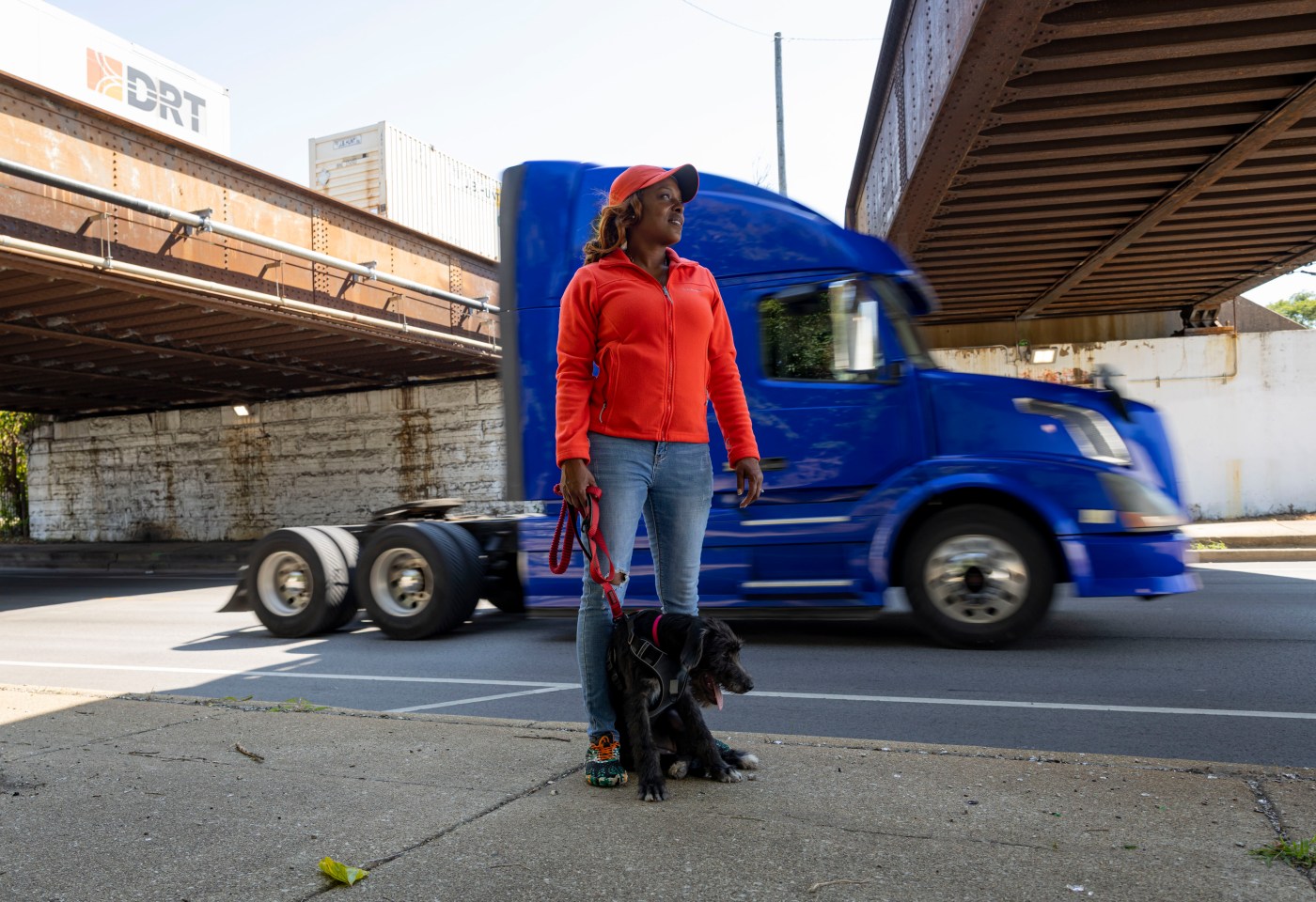Alicia Frizzle asks the bride, the groom, and 200 wedding guests to remove their shoes, close their eyes, and take deep breaths in and out. She speaks in a low, rhythmic voice.
“Note the sound of sprinkling water in front of you, the birds calling in the distance, the wind gently whispering across your face,” she said at Veterans Memorial Park in South Holland last month. “Notice how the grass feels to touch your feet. This is the pulse that animates all creation. One rhythm, one source, one God, one love.”
Frizzle holds the crowd in rapt attention for nine minutes. Dozens of people have their shoes off. It’s a high point in Frizzle’s three-year effort to build a business based on forest therapy—the idea that trained counselors such as herself can help people immerse themselves in nature to improve their physical and mental well-being.
She remembers feeling elated as she drove home to Englewood that night. But elation at connecting with nature is not an easy feeling to sustain in Englewood. And President Donald Trump’s weakening of air pollution regulations on cars and trucks is poised to make Frizzle’s fresh air quest in Englewood and the suburbs more difficult.
Trump’s regulatory attacks don’t generate the same headlines as masked immigration agents tear-gassing protesters. But they’re shaping how Chicagoans, especially those in communities of color, will live and die for decades.
The average life expectancy for Englewood residents, where the population is 88% Black, is 67.7 years, according to the Chicago Department of Public Health. That’s 19.6 years fewer than residents in the Loop, where the population is 87% white, Hispanic, or Asian.
Environmental factors such as air pollution contribute to about a tenth of this longevity gap, according to Dr. Olusimbo Ige, commissioner of the Chicago Department of Public Health. The danger is even greater for people who, like Frizzle, live in neighborhoods sliced by freeways.
“Proximity to motor vehicle traffic is associated with increased exposure to toxic gases and particulate matter including diesel particulates,” Ige said in an emailed statement. This exposure, in turn, is linked to higher rates of asthma and mortality.
By reversing former President Joe Biden’s expansion of federal pollution limits, Trump is giving Illinois fewer tools and resources to improve its poor air quality.
“Very likely, by the end of the year, we will essentially have no regulations in this country, at the state or federal level, that require automakers to improve fuel efficiency or reduce greenhouse gas emissions,” said Chris Harto, an auto analyst for Consumer Reports magazine.
Brian Urbaszewski, director of Chicago’s Respiratory Health Association, described the Trump attack on car and truck pollution controls as cruel.
“It just cements all the existing health disparities we know about,” Urbaszewski said. “It stops progress toward helping people who are the most vulnerable to pollution.”
—
### Neighborhood Complaints
Frizzle, 47, lives on 59th Street in Englewood, in the heart of Chicago’s South Side. Abandoned buildings and vacant lots are everywhere in her neighborhood, along with expressways and strings of Norfolk Southern and CSX rail yards.
During a recent attempted burglary of a train waiting at the Norfolk Southern yard near 59th Street, there was gunfire, and car chases ensued. At least five people were hospitalized, including three Chicago police officers.
Frizzle has plenty of neighborhood complaints. She can’t sit on her front porch without worrying about getting shot, and she had to fight off a sexual predator during one of her forest therapy training sessions in Washington Park.
She was hoping the National Guard would help make Chicago safer, but she’s not seen troops in Englewood. And now she’s worried about recent immigration protests and arrests.
“Can you solve a problem without creating another one?” she asked. She can’t walk her puppy Lyra without worrying about trash and broken glass on the sidewalk.
She has to drive miles to access what she views as adequate health care or buy fresh vegetables. She has to drive 45 minutes out of Englewood to find forests with walking trails that are extensive and safe.
Frizzle is reminded at every turn that driving is a privilege many of her neighbors don’t have. Their lack of mobility, she said, also helps explain why in three years the majority of her forest therapy clients have been white.
The crowd she addressed at the September wedding was not just one of her biggest ever. It also included the largest number of African Americans.
Frizzle and her husband, Jeff, dream of living someday on a farm. She’s scouting around for a place near Chicago, but he’s got his heart set on an Alabama farm his grandfather purchased long ago.
“I’ve got 10 acres,” he said, “that are calling my name.”
—
### The Frizzles and Life in Englewood
For the past six years, Jeff Frizzle, 46, has run his own car repair shop, employing two other workers, just west of the Norfolk Southern tracks on 59th Street.
So far, the Frizzles haven’t joined the out-migration that has cost Englewood three-quarters of its population since 1960. They own nearly a dozen pieces of property in the neighborhood, including the 59th Street home where Jeff was born.
“I think Englewood, like most of the neighborhoods in Chicago, will be turned around,” Jeff said. “Unfortunately, it won’t be turned around with the current residents. It’s going to be gentrified.”
Throughout Jeff Frizzle’s life, the federal government has required automakers to gradually reduce the amount of gasoline their cars and trucks consume per mile, resulting in lower toxic emissions.
Now Trump is saying it’s time to stop.
Since reclaiming the White House, Trump has canceled fines that the federal government has always imposed on automakers who fail to meet corporate fuel economy requirements. He canceled tax credits for electric cars. He challenged the so-called endangerment finding that allows the Environmental Protection Agency to include greenhouse gases on its list of pollutants that must be regulated. He challenged the ability of California and other states to enact stricter auto emission limits than the federal government.
In 1975, when the federal government first imposed fuel economy requirements, the U.S. passenger fleet averaged 13 miles per gallon in real-world driving, according to Harto. Today, the fleet average stands at 28 miles per gallon.
At the end of his term, Biden implemented regulations to increase this number to 35 miles per gallon by 2031. He also lowered greenhouse gas limits to force the sale of more battery-powered passenger vehicles and cargo trucks.
As Trump reverses the Biden changes, Detroit is hedging its bets.
For its flagship Corvette sports car, General Motors Corp. offers a heart-stopping 1,064-horsepower V8 engine. The company relies on big trucks and SUVs for most of its profit. However, for $33,600, General Motors also offers a battery-powered Equinox, which Cars.com rates as the country’s best electric car value.
Bloomberg New Energy Finance predicts electric vehicles will account for 27% of U.S. passenger vehicle sales in 2030. That’s up from around 11% today, but down from the 48% the research firm had predicted for 2030 before the Trump rollbacks.
The problem for Englewood is that, from a health standpoint, its residents need the cleaner air these vehicles make possible much more than the wealthier people who buy electric cars today.
Intermodal rail yards that attract swarms of diesel trucks are a particular hazard in both the city and the suburbs. Diesel particulates are so small they can lodge in the crevices of organs, including the lungs and arteries, causing inflammation.
By implementing California-style requirements for more zero-emission cargo trucks, the Chicago area could prevent 500 deaths and 600 new cases of childhood asthma annually by 2050, solely due to nitrogen dioxide, according to Victoria Lang, an air quality scientist at Northwestern University.
Nitrogen dioxide is a precursor to ozone, an invisible, lung-scarring gas that contributes to asthma and other health ailments.
“It’s been scientifically proven that pollution causes cancer, congenital disabilities, all sorts of nasty things,” said Jeff Frizzle, an asthmatic who’s been able to control his disease so far without medication.
—
### Forest Therapy and New Beginnings
Before starting his car repair shop, Jeff Frizzle worked for 25 years as an engineer at WCEV, a radio station in Belmont Cragin specializing in ethnic music. His mother, Marilyn, hosted a gospel music show on WCEV for 35 years after moving to the area from Alabama in 1961.
The Frizzles met while attending the same Catholic grade school in Englewood. They lost touch but Jeff started messaging Alicia years later after finding her on Facebook.
Throughout their marriage, Alicia Frizzle sometimes worked 13 hours a day managing commercial portfolios in a real estate office. But she found herself drawn more and more to the outdoors.
She bought a bicycle in 2022 and, during that summer, conquered, as she puts it, 17 trails in forests all around Chicago.
“Every time I came home,” she said, “I felt like I was a new version of myself.”
She enjoyed being outdoors so much she bought a pair of boots and began hiking trails in the winter.
And then one day, she remembers, “My husband came up and said, ‘If you give yourself the same amount of time on your own dreams and building your own business as you give to that company, I guarantee you’ll be successful.’”
After completing her forest therapy training, Alicia launched a business that has been growing among secular and religious audiences. She’s had contracts with groups such as the Forest Preserves of Cook County, the Blue Door Neighborhood Centers of Blue Cross and Blue Shield of Illinois, and Willow Creek Community Church.
She offers “wellness journeys” through her website, with prices starting at $170 for a two-hour individual session. She offers free journeys to first responders to thank them for their service.
She had a strong month in July, hosting 14 forest therapy events across three states. She’s putting the finishing touches on a 52-second social media video aimed at women who’ve experienced pregnancy loss.
“I’ve lived this loss twice. I know the silence, the pain and the way your heart can feel like it can’t breathe,” she said. “I found my breath again and that’s why creating a safe space for women to heal is so personal to me.”
—
### A Wedding Grounded in Nature
The groom at the Sept. 12 wedding in South Holland, Deon Owens, was an old friend of Alicia’s. He and his fiancée, Vernice Nelson, booked her to reinforce the “Back to Eden” theme they’d chosen for their wedding.
Nelson, 47, is a registered nurse who runs her own home health company, and Owens, 53, is a freight conductor for the Canadian National Railway. They were thrilled to find love again at this age, Nelson said.
They wanted to start over, to wipe the slate clean, and to launch their new lives in the presence of God, their pastor, their family and friends, and the wondrous outdoors.
Nelson said she was surprised at how much her guests appreciated Alicia Frizzle’s “grounding” ceremony.
“I had people come up to me just in tears, bawling, and saying they really needed that moment,” Nelson said. “Several people said they kept their shoes off during the rest of the wedding and the dinner. They said they hadn’t walked outside with their shoes off in a long time, and it felt so good.”
—
### No Federal Pressure on Pollution Controls
Across Illinois, government officials are bowing to the reality that they can’t make much headway on air pollutants such as ozone, PM2.5, and carbon dioxide without full-throated backing from the federal government.
For example, on Sept. 18, the Illinois Pollution Control Board indefinitely postponed a ruling on a motion filed by environmentalists on whether the state should adopt California-style clean truck requirements.
The state can’t make such a decision, the pollution board ruled, until the federal courts resolve California’s lawsuit over Trump’s attack on its regulatory authority.
The Illinois EPA had argued against the environmentalists, saying, among other things, that the legislature and not the Pollution Control Board would have to decide whether Illinois could afford to continue electric vehicle rebates even after Trump canceled federal support.
IEPA spokeswoman Kim Biggs didn’t respond to questions about the state’s pollution record.
After decades of progress, the Chicago region’s PM2.5 particulate pollution has remained essentially flat since 2015, according to the Illinois EPA. It stabilized at a level almost twice as high as the 5 micrograms per cubic meter of average annual exposure the World Health Organization deems safe.
Before he left office, Biden lowered the allowable U.S. threshold for PM2.5 to an annual average of 9 micrograms per cubic meter of air, down from 12 micrograms.
Six counties around Chicago and three around East St. Louis would fail to meet this new standard, according to the Illinois EPA.
Trump is trying to roll back Biden’s PM2.5 standard too.
In an emailed statement, Anne Vogel, administrator of EPA Region 5 based in Chicago, described the standard as “a major obstacle” to new business permits. But Vogel said the agency hasn’t abandoned a half-century of bipartisan pollution-cutting since the 1970 Clean Air Act.
The agency “will continue to work with our state partners to advance this progress,” she said.
If Trump does roll back the standard, Chicago will no longer have a legal requirement to reduce PM2.5 pollution from its current level, Ige said in her email. This absence of federal pressure wouldn’t make Chicagoans any healthier.
“Literature confirms that a threshold of 9 is better for health outcomes, especially for sensitive groups,” Ige said.
The EPA has already declared the Chicago region to be in non-attainment with the federal ozone standard. This legal status means the city faces tougher and more widespread permitting requirements for ozone from stationary sources, such as factories, especially as Trump blocks continued improvement in cars and trucks.
When smoke from increasingly common Canadian wildfires blankets the Midwest, it makes everyday pollutants such as PM2.5 and ozone much more toxic.
—
### Attention to Air Quality in Chicago
Even as Trump taps the brakes on federal pollution standards, hundreds of activists, government officials, and corporate leaders go to work in Chicago every day trying to clean the air.
The city of Chicago, for example, is building what officials call “the largest community air monitoring network in the world,” and it may require applicants for business permits to analyze how their new operations would exacerbate existing pollution.
“Our hope is to use the data from the community sensors to educate the public on indoor and outdoor air pollution risks and appropriate actions to take on poor air quality days,” Olusimbo Ige of the health department said in her email.
One of Chicago’s most obsessive clean air activists is John Paul Jones. He holds several organizational titles, including president of Sustainable Englewood Initiatives and a consultant for a 1.75-mile nature trail that a group called Grow Greater Englewood is building just north of 59th Street.
The trail would end a few feet from Jeff Frizzle’s car repair shop.
Jones and other organizers hope the trail will spark the development of an “agro-eco” district with community markets, urban farms, restaurants, and food service companies.
To drive around Englewood with Jones is to be constantly interrupted as he answers cellphone calls, passes out flyers, takes notes and pictures, and talks with people at every stop.
He’s bald and his beard has turned gray, but he’s been working this way since he was a teenager.
The nature trail and the CTA’s extension and modernization of its Red and Green lines are among his proudest campaigns, he said.
Jones has been working on the nature trail for nearly two decades. In 2013, he helped negotiate the transfer to the city of the abandoned railroad embankment on which it will be built.
The transfer followed a long public outcry over Norfolk Southern’s effort to expand its 47th Street intermodal yard by purchasing and demolishing hundreds of homes.
Even though Trump is withholding a $20 million allocation for the trail, the city and Grow Greater Englewood have still raised $70 million, and they’re planning a ribbon-cutting in 2027.
Jones said that even in the age of Trump, community organizers can find points of leverage to press their concerns. For example, he hopes to use Norfolk Southern’s proposed merger with Union Pacific to negotiate additional community benefits for Chicago, including those related to air quality, public safety, workforce training, and capital spending.
But Jones still believes Chicago’s Black community should pay more attention to air pollution, even as it grapples with other vast problems such as crime and the lack of affordable housing.
“If the Department of Health can spend all that money on safety, on violence interruption, they need to spend the same kind of attention on air quality,” Jones said. At the very least, he said, the city should train violence interrupters to identify health problems as well.
—
### Voices from the Community
Jeanette Taylor, alderman for the 40th Ward that includes parts of Englewood, said the federal government’s pollution retreat seems familiar to Black Chicagoans except for a new twist.
“You’re talking about a country that has never loved us or respected us. It’s just now that everybody else is getting their ass kicked, OK? Now everyone can see how I feel,” Taylor said.
“Black people are going to do what we’ve always done,” Taylor said. “We’re going to take care of each other and figure it out.”
Alicia Frizzle, for her part, believes the government must do more to protect the air that Chicagoans are breathing.
“Englewood is already a suffering environment,” she said. “We’ve got all these trucks that run on diesel, all the trains, and there’s not a lot of green space to help filter it all out.”
However, Frizzle said she’s seen too much neglect and unfairness, especially in Black and brown neighborhoods such as Englewood, to count on much help from the government now.
She also believes African Americans have more freedoms today than they did generations ago, and she’s determined to make the most of them.
“It’s my job to take the opportunity I have and turn it into something great. I will succeed, whether or not anyone decides to help me.”
—
*John Lippert is a freelancer.*
https://www.chicagotribune.com/2025/10/18/englewood-air-quality-trump/



